Bladen -- Webster CountyBladen, named for Ellen Bladen Gere, daughter of the Lincoln State Journal founder, was surveyed in May 1886 by A.B. Smith for the Lincoln Land Company. Laid out on flat ground east of the pioneer town of "Wells," it is where four sections corner each other in Glenwood precinct in Webster County. Silas and Sylvia Wells had established the Wells post office when they homesteaded there in early 1872. The settlement was known as "Pickleville" after Silas, a truck gardener, had a bumper crop of cucumbers which supplied pickles for the whole area. The town of Wells was also known for "that-there frog pond" on main street that would filled up during the rainy season, and for the bridge on the Little Blue River which could be used "except when it rained." When the people in Wells learned that the Burlington & Missouri River Railroad would be building through the county, they offered the railroad $3,000 to locate the depot at Wells. However a train would not be able to make the grade if it stopped at the bottom of the hill so land was purchased from W.C. Wicks and L.B. Thorne east of Wells. Tracks were laid right through the center of Wells which quickly became a ghost town as merchants and residents scrambled to relocate up on the hill in the new town of Bladen. The first passenger train arrived on Christmas Eve, 1886. The new town's hotel was ready for business with nine bedrooms, a dining room, and separate parlors for ladies and gentlemen. The Bladen House registered names of salesmen from Illinois to California. G.P. Cather, Jr., cousin of Willa Cather, is one of the names found on the pages. Bladen settlers came from Iowa, Ohio, Wisconsin, Michigan, Illinois, and Virginia. A peak population of 500 was reached in 1920, with four grocery stores, two general merchandise stores, three banks, a smoke house, confectionery, newspaper, "The Bladen Enterprise," two cafes, and the Opera house, with movies twice a week. The Webster County Fair has been at Bladen since 1905, when a group of eager young businessmen gave it a home. (The county seat had little interest in having it due to alleged "bad influence from horse races and carnivals." Bladen boasted one of the finest half-mile race tracks in the state when harness racing was popular.) The fair is the big event of the summer, with 4-H exhibits and activities a large part of the programs. Bladen, part of Catherland, was home of Mrs. Pavelka, prototype of "MyAntonia," perhaps Willa Cather's most widely-known book. East Lawn Cemetery, near town, is where the grave of G.P. Cather, Jr., is located. The first Nebraska officer to be killed on duty in France in World War I, he was the red-haired farm lad called "Claude" in Willa Cather's Pulitzer prize-winning novel "One of Ours." Bladen's banks closed in the 1929 crash and never reopened. Then came the Dirty Thirties when many residents of the area left to seek work elsewhere. The newspaper ceased publication in 1936, while several of the town's buildings were sold for taxes. It was said that farmers who toughed-it-out and stayed on were those too poor to move away. Bladen still has a post office, grain elevator, sand and gravel business, and a number of small businesses. The Bladen Opera House, restored by a group of public-spirited people, is alive and well, and in demand for local plays and variety shows. Bladen observed its centennial during the summer of 1986, with Jim Burden, great-grandson of one of the town's first businessmen, as grand marshal of the parade. Due to the shift in population resulting in declining enrollment, 1986 was also the last year for Bladen High School. Bladen and Roseland Districts merged to form the new Silver Lake District. Elementary students now attend school in Bladen, with high school students going to Roseland. Bladen remains a prime shipping center for grain. Many of the land owners are the grandsons and granddaughters of the people too poor to move in the '30s. They are ready to face the second century of a life that, over all, has been pretty good in south central Nebraska. By Frances Berns Sidlo, Rte 2 Box 161, Red Cloud, Nebraska 68970. Photos courtesy of Robert Berns, Geneva Lewis, and LaVone Ruschke.
ADDITIONAL MATERIAL: The First 100 Years published in 1986. |
 When B&MR Railroad built through Webster County in 1886, the little town of "Wells" moved up the hill to the new town of "Bladen." 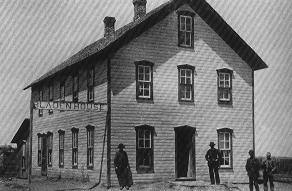 Bladen House, one of the first buildings in the new town  Dr. Charles Koehler built his drug store in 1886. Pictured are the Koehlers and their two daughters,Faye and Mae, along with Thomas Burden and his dog. 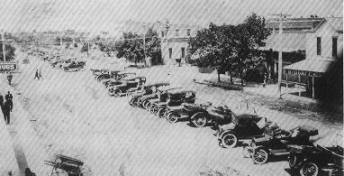 Bladen boasted of many auto's in the early-years. A telephone meeting brought everyone to town. n.d.  The two-story Opera House build in 1913 served as a lodge, graduation, and plays. It is undergoing restoration in 1988. 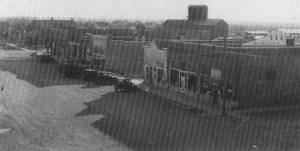 The west side after two buildings were destroyed by fire in 1929. 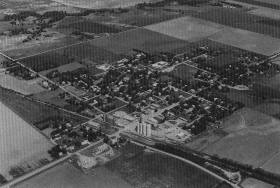 Bladen as it looks today from the air. It will always be a little town, but it is OUR VERY SPECIAL LITTLE TOWN 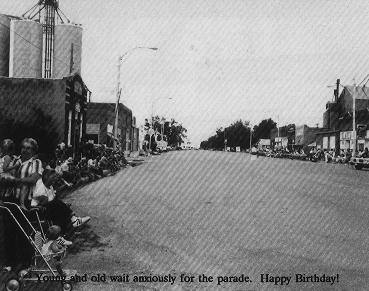 Young and old wait anxiously for the 1986 centennial celebration parade. Happy Birthday! |